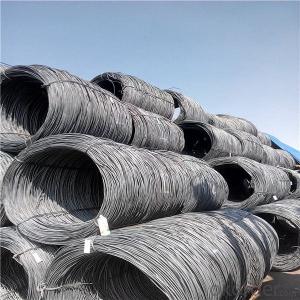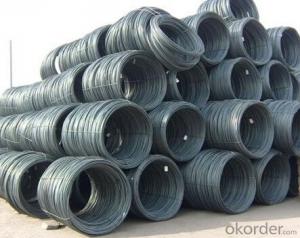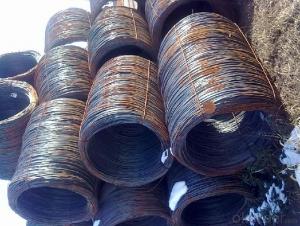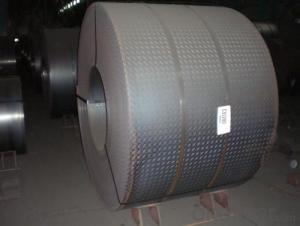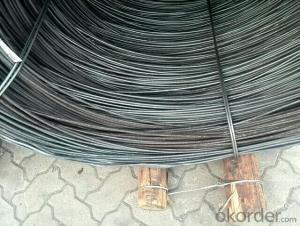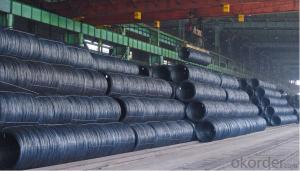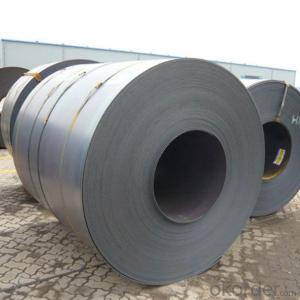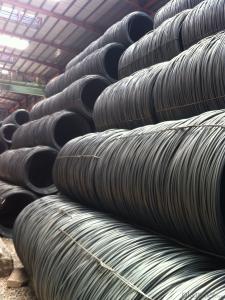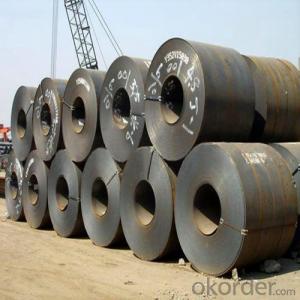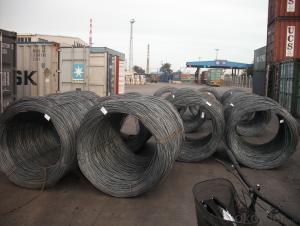Steel wire rod in coils buy direct from china manufacturer
- Loading Port:
- China main port
- Payment Terms:
- TT OR LC
- Min Order Qty:
- 100 m.t.
- Supply Capability:
- 17623 m.t./month
OKorder Service Pledge
OKorder Financial Service
You Might Also Like
Specification
Wire rod is a rolled alloy or nonalloy steel product, produced from a semi (e.g. bloom) and having a round,
rectangular or other cross-section. Particularly fine cross-sections may be achieved by subsequent cold
forming (drawing). Wire rod is wound into coils and transported in this form.
Wire rod is used for many different products. Depending upon how it is cold formed and heat treated, wire is used,
for example, to produce not only wire ropes, barbed wire, wire mesh and nails, but also springs, welded wire
mesh and reinforcement wire.
Our service:
(1) We cooperate with famous factories with advanced equipment and well trained workers.
(2) We can provide factory price with trading company service.
(3) We continuously work on the improvement of our processes, guaranteeing
consistently high standards of quality to keep none compensation.
(4) We guarantee 24 hours response and 48 hours solution providing service.
(5) We accept small order quantity before formal cooperation.
(6) We deliver the agreed quality at the agreed time, reacting to changes in
customer wishes in a flexible way.
(7) Due to our volume and selling power, we have excellent freight rates with
shipping lines.
(8) We strive to always be fair and honest in our dealings with customers.
(9) We strive to work together with customers to achieve much more than we can
achieve alone.
(10) Through our passion and commitment we aim to be a market leader in all our
key markets. To maintain our position as market leader we must continue to add
value in all that we do.
Product Description :
Standard | AISI, ASTM, BS, DIN, GB, JIS |
Material/steel grade | Q195-Q235,SAE1006B,SAE1006CR, SAE1008B, SAE1008CR, SAE1010B, SAE1018B, or according to customers requirements |
Wire Gauge | 5.5-12mm |
Coil weight | 1.8-2.1mts |
MOQ | 25MT |
Delivery Time | 15-30 days after receipt of L/C or deposit by T/T |
Packing | In coil and load in container, if large quantity, by bulk vessel; Can be packed as customers' special requirements |
Payment terms | 1).100% irrevocable L/C at sight. 2).30% T/T prepaid and the balance against the copy of B/L. 3).30% T/T prepaid and the balance against L/C |
Application | widely used in machinery parts, manufacturing industry, electronics industry, metal tools and others |
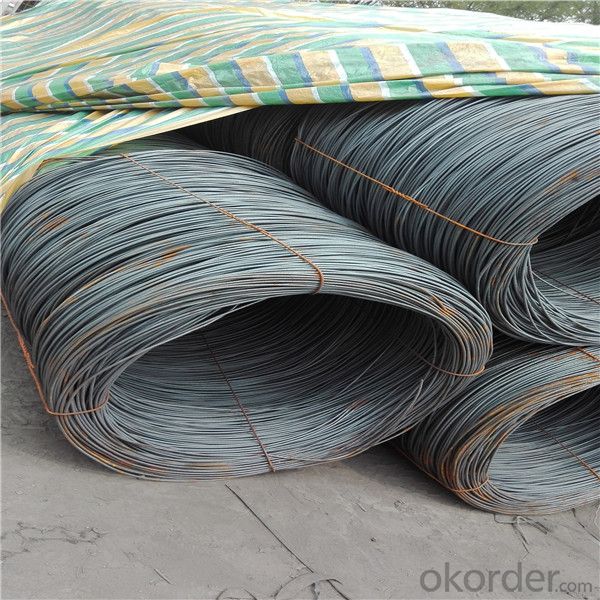
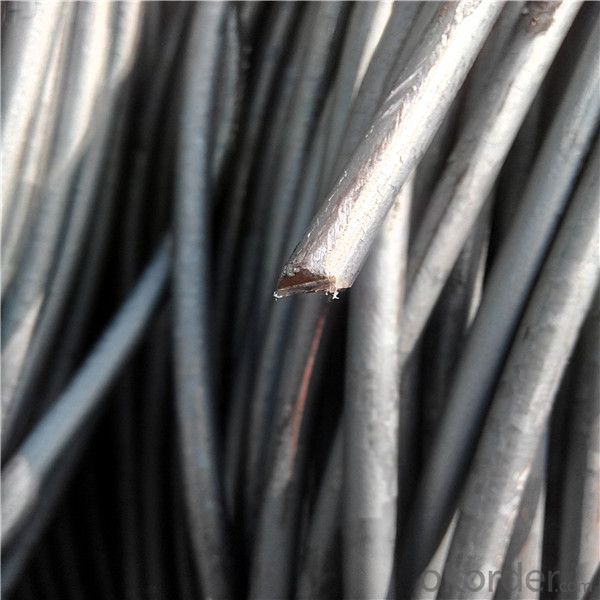
Application :
Mainly used in building and construction as binding wire, tie wire and baling wire; also can be make
for wire mesh.
Packing :
Hot-rolled wire rod is held in a unit with at least four steel straps in the
transverse direction and transported and stored without further packaging.
Before
the steel strapping is applied, the wire rod must be sufficiently compressed.
The strapping is fixed in the transverse direction with a single circumferential
strap so that the strapping does not slip and cause the coil to come apart.
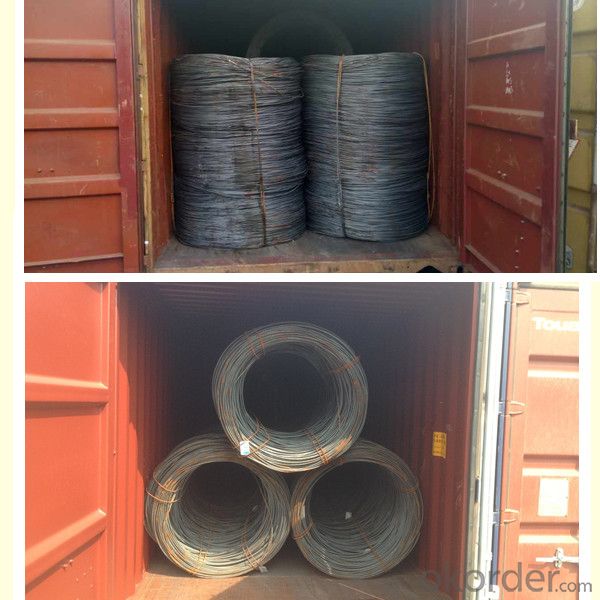
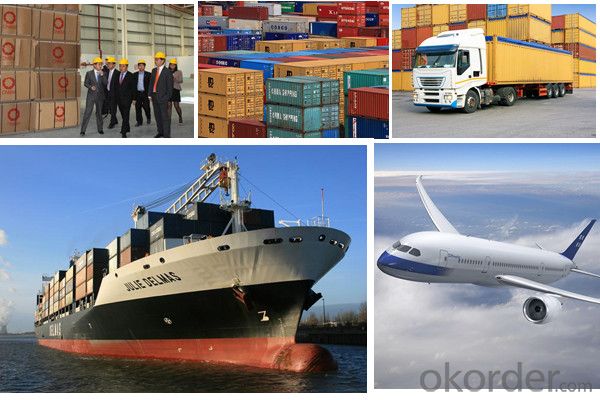
FAQ:
1.Q:Can you accept mixed order?
A: Yes, mixed acceptable .
2. Q: How can I buy CNBM products in my country?
A:Please send us an inquiry or email ,we will reply to you if there is distributor in your country
3. Q: Can we visit your factory?
A: Warmly welcome. Once we have your schedule, we will arrange the
professional sales team to follow up your case.
4. Q: How long does it take to get the product if i place an order?
A:With the process of your requirements,we will pack and deliver in 3
-7 days. If it is by sea shipment,it will take 15-45 days depending on different locations
- Q: What are the common industry best practices for steel wire rod professionals?
- Some common industry best practices for steel wire rod professionals include ensuring the quality and consistency of the wire rod through regular testing and inspection, implementing efficient production processes to minimize waste and maximize productivity, adhering to strict safety protocols to protect workers and prevent accidents, staying updated with advancements in technology and equipment to improve efficiency and quality, and establishing strong communication and collaboration with suppliers, customers, and other stakeholders to meet their specific requirements and ensure smooth operations.
- Q: What are the standard fatigue resistance requirements for steel wire rod?
- The fatigue resistance requirements for steel wire rods vary depending on the specific application and industry standards. However, there are some general guidelines that can be taken into consideration. Industries such as automotive, aerospace, and construction place great importance on fatigue resistance when it comes to steel wire rods. These rods experience cyclic loading and stress, which can result in fatigue failure if the material is not designed to withstand these conditions. Fatigue tests, such as rotating bending or axial fatigue tests, are typically used to determine the fatigue resistance requirements for steel wire rods. These tests subject the wire rod to repeated cycles of loading and unloading under specific conditions, such as stress amplitude and frequency. Parameters such as fatigue strength, fatigue life, and fatigue limit are often used to quantify the fatigue resistance of steel wire rods. Fatigue strength represents the maximum stress level that the wire rod can endure for a specified number of cycles without failure. Fatigue life indicates the number of cycles that the wire rod can sustain before failure occurs. The fatigue limit, also known as endurance limit, is the stress level below which the wire rod can theoretically endure an infinite number of cycles without failure. The specific fatigue resistance requirements for steel wire rods can vary based on factors such as the intended use, material composition, and expected service life. These requirements are typically defined by industry standards and specifications, such as those established by organizations like ASTM or ISO. Manufacturers and engineers must carefully consider the fatigue resistance requirements for steel wire rods to ensure the safety and reliability of the final products. This involves selecting the appropriate material grade, conducting thorough testing and analysis, and adhering to industry standards and specifications.
- Q: How is steel wire rod used in the manufacturing of wire for suspension systems in vehicles?
- Steel wire rod is used in the manufacturing of wire for suspension systems in vehicles as it provides high strength and durability. It is first transformed into wire through a series of processes such as drawing, annealing, and coating. The resulting wire is then used to create various components of the suspension system, such as springs, sway bars, and control arms. The use of steel wire rod ensures that these suspension components can withstand the heavy loads and vibrations experienced during vehicle operation, contributing to a smooth and stable ride.
- Q: How does the yield strength of steel wire rod vary with different grades?
- The yield strength of steel wire rod can vary significantly across different grades, as the composition and heat treatment process of each grade are unique. The yield strength refers to the maximum stress a material can withstand before permanent deformation occurs. To meet the specific requirements of various applications, different grades of steel wire rod are developed with distinct mechanical properties. Generally, higher grades possess higher yield strengths. This is achieved by adjusting the chemical composition and heat treatment processes during the manufacturing phase. For instance, low carbon steel wire rod grades typically exhibit lower yield strengths, making them suitable for applications that prioritize flexibility and ductility, such as wire mesh and fencing. Conversely, high carbon steel wire rod grades are characterized by their superior yield strengths, making them ideal for applications that demand increased strength and durability, like automotive parts and construction materials. The yield strength of steel wire rod can also be influenced by factors such as the size and shape of the rod, the presence of alloying elements, and the manufacturing process itself. Therefore, it is essential to consider these factors when selecting the appropriate grade of steel wire rod for a specific application, ensuring optimal performance and safety.
- Q: How is steel wire rod used in the manufacturing of wire forms for recreational equipment?
- Steel wire rod is an essential component used in the manufacturing of wire forms for recreational equipment. This type of wire has high tensile strength, durability, and flexibility, making it ideal for creating various wire forms that are commonly found in recreational equipment such as playground structures, sports equipment, and outdoor fixtures. In the production of wire forms for recreational equipment, steel wire rod is initially processed through a series of steps to ensure its quality and desired properties. The wire rod is first drawn through a series of dies to reduce its diameter and increase its length. This process, known as wire drawing, results in a wire that is consistent in size and has improved tensile strength. Once the steel wire rod has been drawn, it can be further manipulated to create different wire forms. For instance, it can be bent, cut, or welded to form intricate shapes that are required for specific recreational equipment. The flexibility of steel wire rod allows for the production of various wire forms, such as loops, hooks, rings, and coils, which are crucial components in different recreational equipment. These wire forms made from steel wire rod are then incorporated into the manufacturing process of recreational equipment. For example, in playground structures, steel wire rod is used to create strong and secure loops or hooks that connect different components together, providing stability and strength to the overall structure. In sports equipment, steel wire rod is often used to form durable and resilient frames for products such as basketball hoops, soccer goals, or fencing materials. Additionally, steel wire rod is used in the manufacturing of wire forms for outdoor fixtures like swings, hammocks, and bike racks. These wire forms are designed to withstand constant usage, exposure to harsh weather conditions, and heavy loads. Steel wire rod ensures that these wire forms are strong, reliable, and long-lasting, ensuring the safety and enjoyment of users. In conclusion, steel wire rod plays a vital role in the manufacturing of wire forms for recreational equipment. Its high tensile strength, durability, and flexibility make it a preferred choice in creating various wire forms that serve as essential components in recreational equipment, providing stability, strength, and safety to users.
- Q: What are the different surface treatment processes used for steel wire rod?
- Some of the different surface treatment processes used for steel wire rod include hot-dip galvanizing, electro-galvanizing, phosphating, and coating with oil or polymer-based materials.
- Q: How is steel wire rod used in the production of wire mesh for industrial sieving?
- Steel wire rod is a crucial component in the production of wire mesh for industrial sieving. Wire mesh is commonly used in various industries, such as mining, construction, and agriculture, for the purpose of separating and classifying different materials based on their size and shape. The steel wire rod serves as the raw material for wire mesh production. It is first processed through a series of manufacturing steps to transform it into a suitable form for creating the mesh. The wire rod is typically drawn through a series of dies to reduce its diameter and increase its length. This process is known as wire drawing and results in a thin and elongated wire. Once the wire rod has been drawn, it is then woven or welded together to form the wire mesh. The weaving process involves interlacing the wires in a crisscross pattern, creating a strong and durable mesh structure. On the other hand, the welding process involves fusing the wires together at their intersections using heat or pressure, resulting in a solid and stable mesh. The choice between weaving and welding depends on the specific requirements of the application. Weaving is commonly used for producing wire mesh with smaller openings and finer mesh sizes, while welding is preferred for larger openings and heavier wire diameters. The wire mesh produced from steel wire rod offers several advantages for industrial sieving. Firstly, steel is a highly durable and robust material, capable of withstanding harsh environments and heavy loads. This ensures that the wire mesh can endure the constant impact of materials during the sieving process without losing its structural integrity. Additionally, steel wire rod provides excellent tensile strength, allowing the wire mesh to maintain its shape and resist deformation under tension. This is particularly important for applications that involve high-pressure sieving or require the mesh to be stretched tightly over a frame. Moreover, steel wire rod can be manufactured with different coatings or treatments to enhance its resistance to corrosion, abrasion, or other forms of wear and tear. This further extends the lifespan of the wire mesh, making it suitable for long-term industrial use. In summary, steel wire rod is an essential component in the production of wire mesh for industrial sieving. Its versatility, durability, and strength make it an ideal raw material for creating wire mesh that can withstand rigorous sieving applications in various industries.
- Q: How is steel wire rod used in the production of wire ropes for cranes?
- Steel wire rod is a crucial component in the production of wire ropes for cranes. It serves as the raw material that is carefully shaped and formed into strands, which are then twisted and braided together to create the strong and durable wire ropes. The high tensile strength and resilience of the steel wire rod ensure that the wire ropes can withstand heavy loads and constant stress, making them ideal for lifting and moving heavy objects in crane operations.
- Q: How is steel wire rod used in the production of mesh fencing?
- Steel wire rod is an essential component in the production of mesh fencing. The wire rod serves as the primary material used to create the individual wires that are woven or welded together to form the mesh pattern. To begin the manufacturing process, the steel wire rod is first processed through a series of mechanical operations such as drawing and annealing to enhance its strength and flexibility. This ensures that the wire is durable and capable of withstanding external forces and environmental conditions. Once the wire rod has been processed, it is then fed into a machine that transforms it into individual wires with the desired diameter. These wires are then woven or welded together to form the mesh pattern commonly seen in fencing. Woven mesh fencing is created by interlocking the wires in a crisscross pattern, resulting in a sturdy and flexible structure. This type of mesh fencing is commonly used in agricultural applications, such as livestock enclosures or perimeter fencing. On the other hand, welded mesh fencing is made by welding the wires at their intersection points, creating a rigid and strong mesh structure. Welded mesh fencing is frequently used in industrial settings, construction sites, or for security purposes, as it provides a high level of strength and durability. In both cases, the steel wire rod is the crucial raw material that forms the foundation of the mesh fencing. It ensures that the fencing is capable of withstanding various external factors such as weather conditions, impacts, and pressure. Additionally, steel wire rod is often galvanized or coated with protective materials to enhance its resistance to corrosion, further increasing the longevity and durability of the mesh fencing.
- Q: How is steel wire rod used in the manufacturing of springs?
- Steel wire rod is commonly used in the manufacturing of springs due to its high tensile strength and durability. It serves as the raw material for the production of spring wires, which are then formed and treated to create various types of springs. The flexibility and resilience of steel wire rod allow springs to withstand repeated cycles of compression and extension, making it an essential component in the manufacturing process.
Send your message to us
Steel wire rod in coils buy direct from china manufacturer
- Loading Port:
- China main port
- Payment Terms:
- TT OR LC
- Min Order Qty:
- 100 m.t.
- Supply Capability:
- 17623 m.t./month
OKorder Service Pledge
OKorder Financial Service
Similar products
Hot products
Hot Searches
Related keywords
